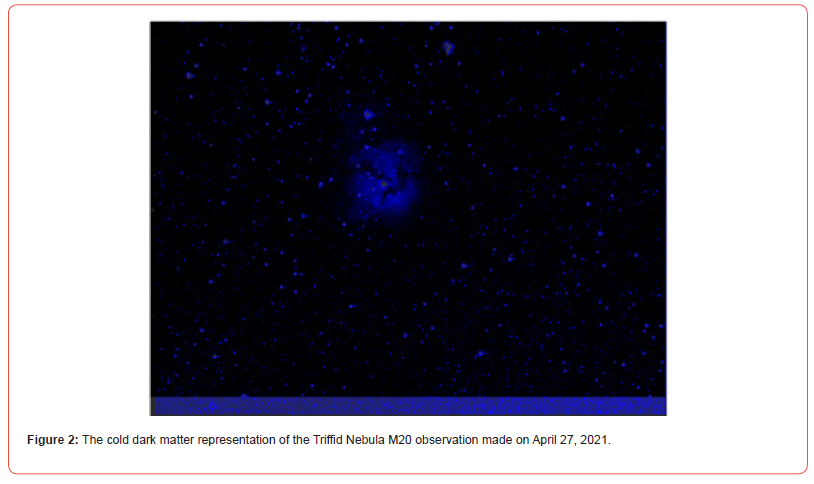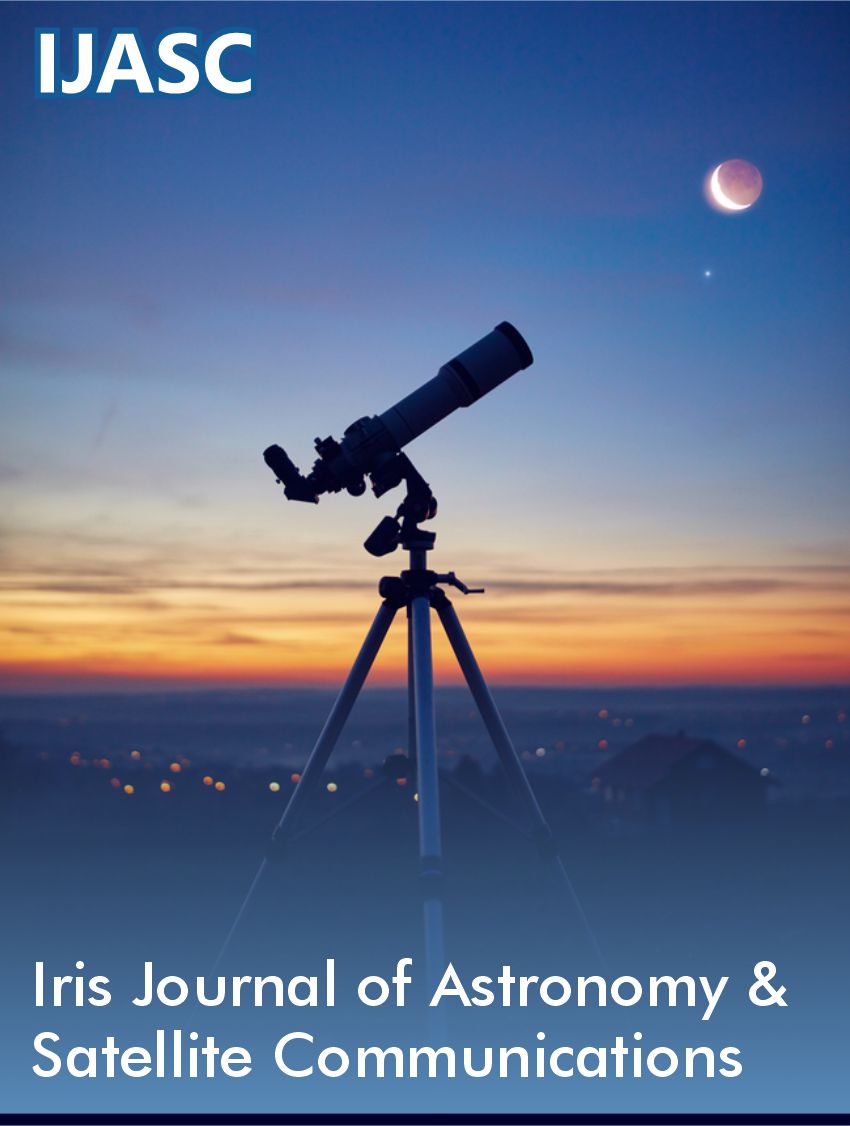 Research Article
Research Article
Nemesis Formation Around Black Holes with Evidence
Yang I Cao, Founder, Scientifique Global Limited, Kowloon, Hong Kong
Received Date:April 10, 2024; Published Date:June 03, 2024
Abstract
I briefly present the evidence on extragalactic planets equivalent to the proposed counterpart Nemesis in the solar system. I theorize that the phenomenon is common for black holes, and they aid star cluster formation. The observational evidence for these objects are presented with the instances of the Triffid Nebula M20 with ground-based telescope and M87 with the NASA space-based telescope data. I deem that an alternative formation of parallaxes should be in place for the calculations of their absolute magnitude and lensing for white hole observations. Further, I discuss the value of Pluto to an evidence-driven approach to cosmology.
Keywords:black hole physics; primordial nucleosynthesis; parallaxes; virtual observatory tools; quasars: supermassive black holes; galaxies;structure.
Introduction
Nemesis was initially theorized for the periodical catastrophic extinctions of lifeforms in the solar system with comet showers. While the catastrophic scenarios are causally excluded from Nemesis, the sun’s mysterious companion planet is not wiped out of existence in scientific literature [1]. In the framework of Modified Newtonian Dynamics (MOND) studies with the galactic center, Nemesis was proposed to explain the perihelion precession of Saturn in the solar system [2]. Nemesis is thought to be cold and dark and follow a highly elliptical orbit as a brown-dwarflike companion to the sun between 0.07 and 0.0002 solar masses [2,3]. The estimation of the mass ratio, however, is highly uncertain with the modification of general gravity supplemented by dark energy and antigravity in the cosmological mix [4]. Nevertheless, either in the archeological or the contemporary theoretical models there is room for the phantom planet of empirical and theoretical significance [5,6]. In the research, I report the findings on the Nemesis-equivalent planet in M87 with the NASA multispectral data, and further the solar Nemesis theory on the basis of its cosmological causal formation. When I first researched the M87 data from the NASA Data Challenge in 2021, I proposed the possible and probable existence of the type of planets near black holes contributed by oscillation with ionization and electron pulsation [7]. The interests for research, however, grow out of the stable detection of white holes through Nemesis with the mathematical principles of Shannon entropy with the infinite product form of tidal parameter K≡(GM_X)/(r_X^3 ) of the still undiscovered body X [2,8].
Methods
It is not a rare experience in extragalactic source observations that a peculiar diamond-shaped highlight appears in the image just like that in Figure 1. The phenomenon has largely been neglected and overlooked, but there is indeed substance in the materials when I attempted to calibrate the cold dark matter representations of the observations seen in Figure 2 [9]. The nature of the phenomenon was only further analyzed with my data processing with the multiwavelength NASA mission data on M87 with the black hole jet tail’s influence on star formation seen in Figure 3. The black hole jet tails, theoretically formed by the centrifugal force of ejected materials from white holes, fuel the Nemesis-equivalent stars and oscillate their polarity, demonstrated in Figure 4.




Result
The analyses suggest the visibility of Nemesis observation would be flashing with electronic devices, and their elliptical orbital phase follows a two-force model instead of Newtonian or MOND gravitational expectations. The polarity interpretations of Nemesis explain the causality of solar wind, and “big rip” phenomena in observations with electronic devices in instances. The absolute magnitude of Nemesis is expected to deviate from the current formula, and its correct formulation may need to involve the black hole singularity. Nemesis’ role in star formation with macroscopic spatial oscillation may imply that the phantom planet can be a new category of celestial object. In theory, their orbital phase is not primarily influenced by the companion stars, nor are they stars in themselves. In observational astronomy and observational cosmology, it is theorized that lensing through Nemesis’ absolute magnitude is the probable way in observing white holes. For that, an alternative solution for parallaxes needs to be proposed.
Discussions
Pluto was once categorized as a planet for its near recent trajectories orbiting the sun. It has been noted, however, that energetic phenomena exist on the dwarf, contradicting the Big Bang model’s explanations on dwarfs being remnants of energyexhausted stars [10]. The discovery, or re-discovery, of Pluto proceeded the death of Percival Lowell, who gave the theoretical insights of Planet X / Nemesis [11]. No records of extensive analyses from the discovery to P. Lowell’s original propositions [12] have been located in the research, with the impossibilities of verifying the discovery with the original author, but the post hoc evidence of the partly celestial and partly terrestrial components of Pluto suggests it the possible match, if not small systematic errors by an underestimate of the mass of Neptune [12], from P. Lowell’s reasoning from a celestial mechanic methodological perspective. What triggered my interest in the research, apart from the relevance of the Nemesis hypothesis to my previous theorization, was the macroscopic nuclear patterns of the planets from celestial to terrestrial planets. The Big Bang cosmology’s explanatory offers on the thermodynamic patterns of the solar system’s planets followed a linear construct of time progression, while Conformal Cyclic Cosmology (CCC) considered for the alternative possibilities on the originations of the ready-made solar system objects [13]. If Pluto is purely a planet, then the possible explanation exists with the CCC framework that its formation was caught between one aeon and another; if it was not, my proposition would be that the oscillation between the Milky Way’s black hole and white hole gave birth with the original materials to Pluto just as how they did to that of the sun [7], and more dense-energy-cored stellar objects from the like exist within our galaxy with strong energy resistance in the atmospheric mass density, formed from the collision momenta of the black hole seed and the white hole seed [14].
Conclusions
The acceleration of the barycenter of the solar system [12] is not only a concern in celestial mechanics, but also in an evidencedriven approach in cosmology. The incorporation of quantum gravity theories into celestial mechanics will be a critical step for the evidence-driven cosmological implications, such as with the quantification of the ground state of the graviton [15]. A pragmatic mutual ground has been reached from the opposite ends between the search for Nemesis and the quest for an evidencedriven approach to cosmology with black hole and white hole thermonuclear binding [2,16]. Defamiliarization of the solar system started with the search for Planet X / Nemesis and the evidential values of Pluto to cosmology is still an under-explored field. If the atom can tell about the universe, then there is one question, if answered, that can shed further insights into the phenomenon of the planetary formation in the solar system: why does the electron’s path dependency differs from the positron in the nuclei?
Acknowledgments
I thank my penpal Steve for mentioning the Nemesis and phantom planet theory that reminded me of my previous findings, and Mahika Prasad for reminding me of the seemingly far-fetched question I’ve always had since learning nuclear physics and chemistry.
Funding
The research is not funded.
Data Availability
The observation data with Micro Observatory is openly accessible on Zenodo with the DOI: 10.5281/zenodo.6426887. The raw data of the NASA data analyzed is publicly available on the NASA Data Challenge archive page with the URL: https://waps.cfa.harvard.edu/eduportal/js9/ softwareChallenge_Archive.php
References
- Melott AL, Bambach RK (2010) Nemesis reconsidered. Mon Not R Astron Soc: Letters 407(1): L99-L102.
- Iorio L (2010) The Perihelion precession of Saturn, planet X/Nemesis and MOND. The Open Astronomy Journal 3: 1-6.
- Chobanu MI, Philippov J (2016) Nemesis, Tyche, Planet Nine Hypotheses. I. Can We Detect the Bodies Using Gravitational Lensing? Publications of the Astronomical Society of Australia 33: e033.
- Tripathy SK, Mishra B (2020) Phantom cosmology in an extended theory of gravity. Chinese Journal of Physics 63: 448-458.
- Chimento LP, Lazkoz R, Maartens R, Quiros I (2006) Crossing the phantom divide without phantom matter. Journal of Cosmology and Astroparticle Physics 2006: 004.
- Cunningham C (2016) Cunningham C. ed., Discovery of the First Asteroid, Ceres: Historical Studies in Asteroid Research. Springer International Publishing, Cham, p. 1.
- Pachankis YI (2022a) Eliva Press, Moldova, Europe.
- Shannon CE (1948) A mathematical theory of communication. Bell System Technical Journal 27(3): 379-423.
- Pachankis YI (2022b) White Hole Observation: An Experimental Result. International Journal of Innovative Science and Research Technology (7): 779.
- Ksanfomality LV (2016) Pluto: Dwarf Planet 134340. Solar System Research 50(1): 67-80.
- Science Reference Section L.o.C., 2019. Library of Congress.
- Iorio L (2009) Constraints on planet X/Nemesis from Solar System's inner dynamics. Monthly Notices of the Royal Astronomical Society 400(1): 346-353.
- Gurzadyan VG, Penrose R (2016) CCC and the Fermi paradox. The European Physical Journal Plus 131(1).
- Ricarte A, Natarajan P (2018) The observational signatures of supermassive black hole seeds. Monthly Notices of the Royal Astronomical Society 481(3): 3278-3292.
- Marongwe S (2024) Energy momentum localization in quantum gravity. Physica Scripta 99(2).
- Pachankis YI (2023) Before or After: The Big Bang Paradox. Cosmology – The Past, Present and Future of the Universe. IntechOpen, Rijeka.
-
Yang I Cao*. Nemesis Formation Around Black Holes with Evidence. Iris Jour of Astro & Sat Communicat. 1(3): 2024. IJASC. MS.ID.000511.
-
Black hole physics; primordial nucleosynthesis; parallaxes; virtual observatory tools; quasars: supermassive black holes; galaxies; structure
-

This work is licensed under a Creative Commons Attribution-NonCommercial 4.0 International License.






